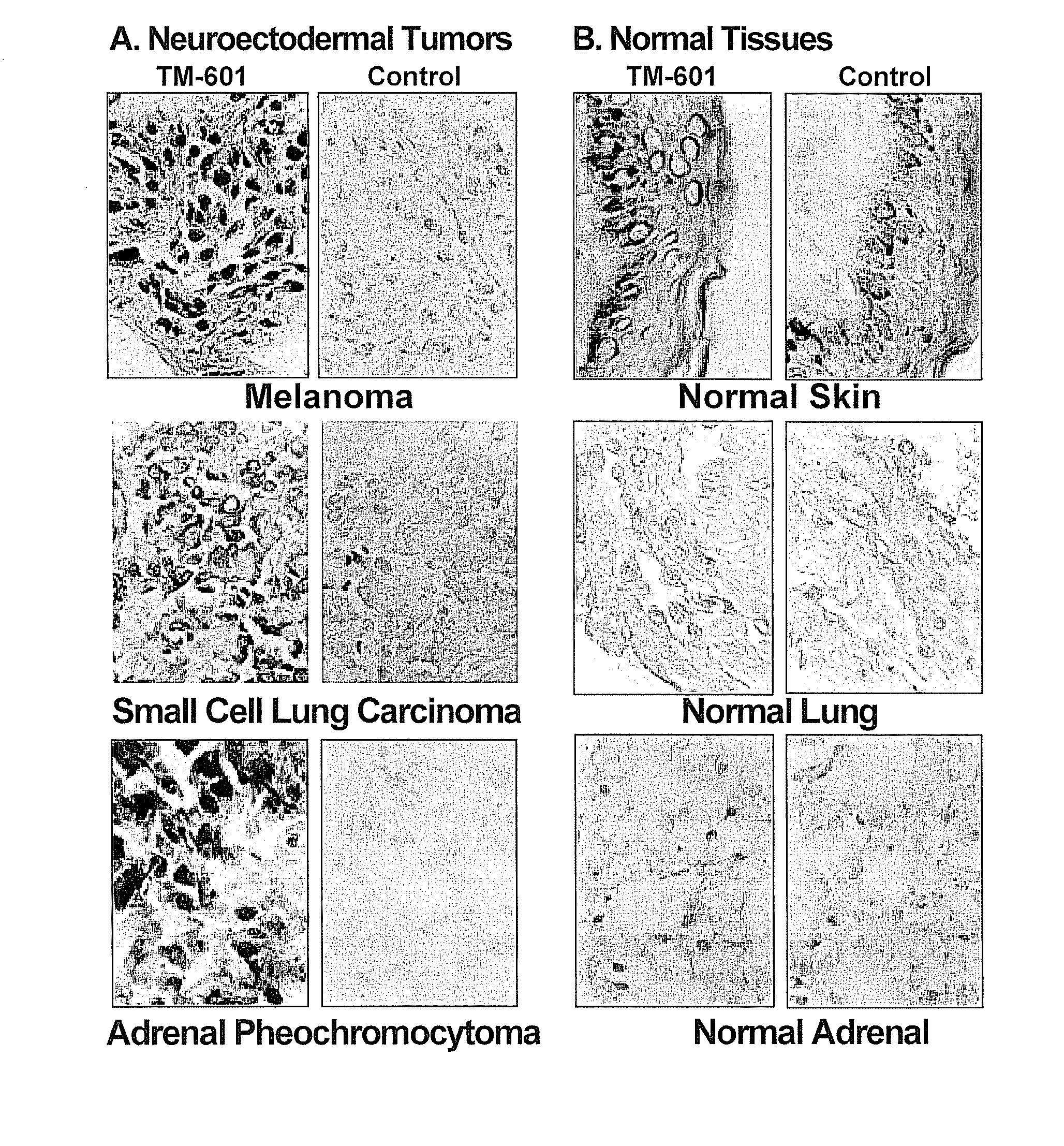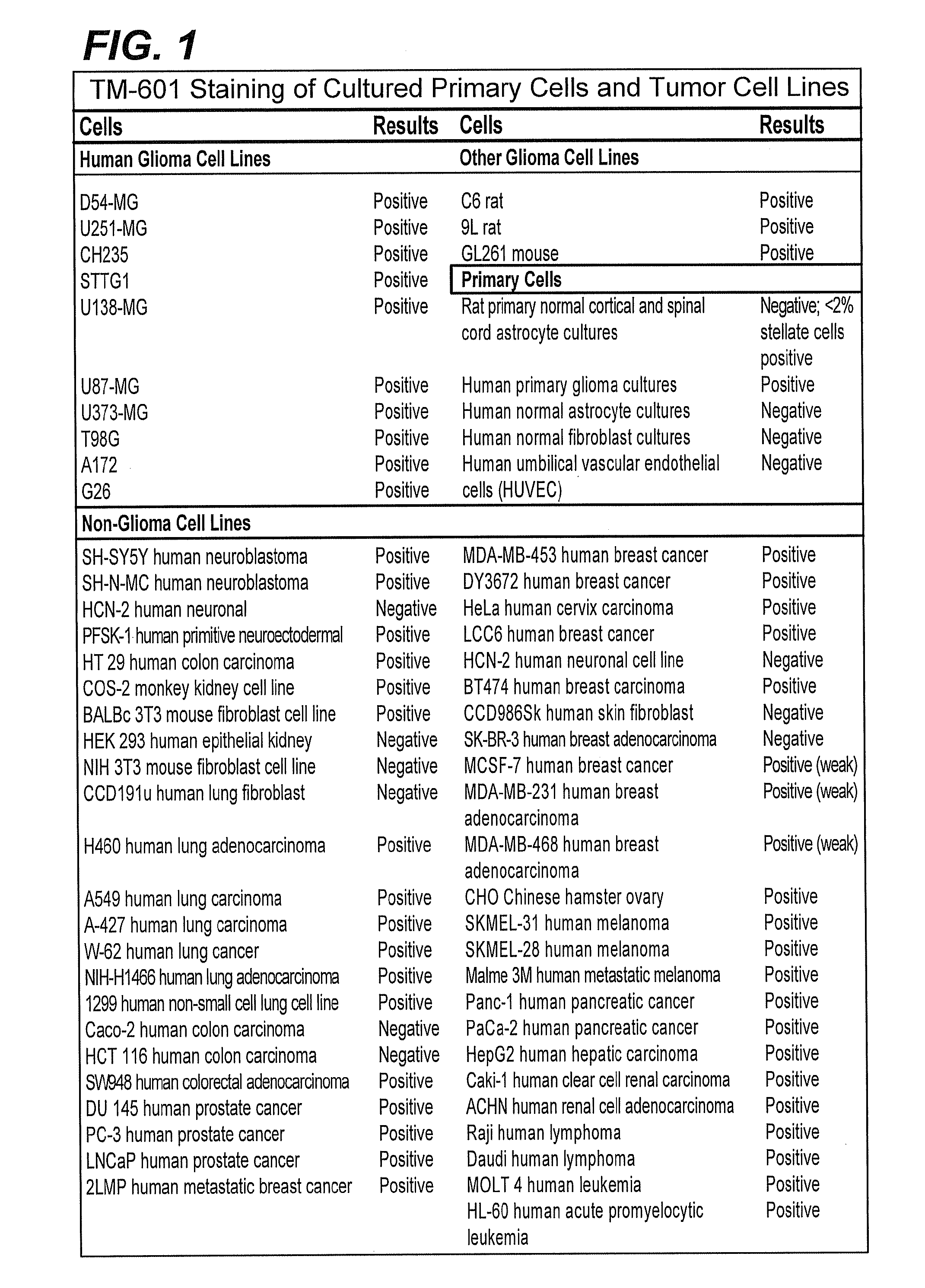Systemic Administration of Chlorotoxin Agents for the Diagnosis and Treatment of Tumors
a chlorotoxin agent and tumor technology, applied in the field of systemic administration of chlorotoxin agents for the diagnosis and treatment of tumors, can solve the problems that intracavitary administration may not be the most appropriate delivery route, and achieve the effects of enhancing survival time, effective delivery, and effective intravenous delivery
- Summary
- Abstract
- Description
- Claims
- Application Information
AI Technical Summary
Benefits of technology
Problems solved by technology
Method used
Image
Examples
example 1
In Vitro Cell Binding of TM-601 and Biotinylated TM-601 (TM-602)
[0149]The binding of TM-601, a 36 amino acid peptide originally isolated from Leiurus quinquestriatus scorpion venom, to tumor cell lines and normal primary cell cultures has been studied. Results obtained further corroborated the previous preliminary observation that TM-601 binds selectively to many different tumor types. Human, rat, and mouse glioma cell lines, cultured primary cells, and non-glioma cell lines, including those from human, monkey, rat, hamster, and mouse, were tested for TM-601 binding. Additionally, many non-glioma tumor lines including for example tumor lines derived from lung, colon, prostate and melanoma tumors were also found to bind TM-601. In contrast, under the experimental conditions used, a number of primary cultured cells (rat and human astrocytes) and non-glioma cell lines (human lung fibroblast, human skin fibroblast, human umbilical vascular endothelial cells, human neuronal cells, and 3T...
example 2
Non-labeled TM-601 Does Not Decrease Tumor Cell Growth In Vitro
[0153]An in vitro cell line screen containing 56 different human tumor cell lines, representing leukemia, melanoma and cancers of the lung, colon, brain, ovary, breast, prostate and kidney was performed by the National Cancer Institute. TM-601 was submitted to the screening service. The results obtained showed that TM-601 was not cytotoxic to any of the cell lines tested. As a follow-up experiment, a single cell line, Panc-1, was tested at a range of serum concentrations (10%, 5%, 2%, 1%) to determine whether cytotoxic activity was evident in low serum growth conditions. No significant cytotoxicity of chlorotoxin was observed, indicating that the primary mechanism of action for chlorotoxin is not via a direct cytotoxic effect on the tumor cells.
example 3
In vitro Tissue Binding of Biotinylated TM-601
[0154]Histochemical staining studies using biotinylated TM-601 (TM-602) were performed to localize TM-601 binding sites on fixed tissues embedded in paraffin or frozen sections of human biopsy and / or autopsy specimens. Thus far, over 200 brain tumor biopsy and autopsy specimens have been evaluated for TM-601 binding. Included in the studies were gliomas, other malignancies, and non-neoplastic tissues. The results of this study and subsequent studies are presented in FIG. 3.
[0155]In general, nearly all gliomas demonstrated prominent staining activity for TM-601, while normal, non-tumor tissues did not. The percentage of TM-601 positive cells within a given tumor ranged from 50-98% and increased with increasing WHO malignant grade. An example of glioma specific staining with TM-601 is shown in FIG. 4. In addition, all patient brain tumor tissue samples from a Phase I clinical study showed robust biotinylated TM-601 staining, while non-canc...
PUM
| Property | Measurement | Unit |
|---|---|---|
| molecular weight | aaaaa | aaaaa |
| molecular weight | aaaaa | aaaaa |
| molecular weight | aaaaa | aaaaa |
Abstract
Description
Claims
Application Information
 Login to View More
Login to View More - R&D
- Intellectual Property
- Life Sciences
- Materials
- Tech Scout
- Unparalleled Data Quality
- Higher Quality Content
- 60% Fewer Hallucinations
Browse by: Latest US Patents, China's latest patents, Technical Efficacy Thesaurus, Application Domain, Technology Topic, Popular Technical Reports.
© 2025 PatSnap. All rights reserved.Legal|Privacy policy|Modern Slavery Act Transparency Statement|Sitemap|About US| Contact US: help@patsnap.com



